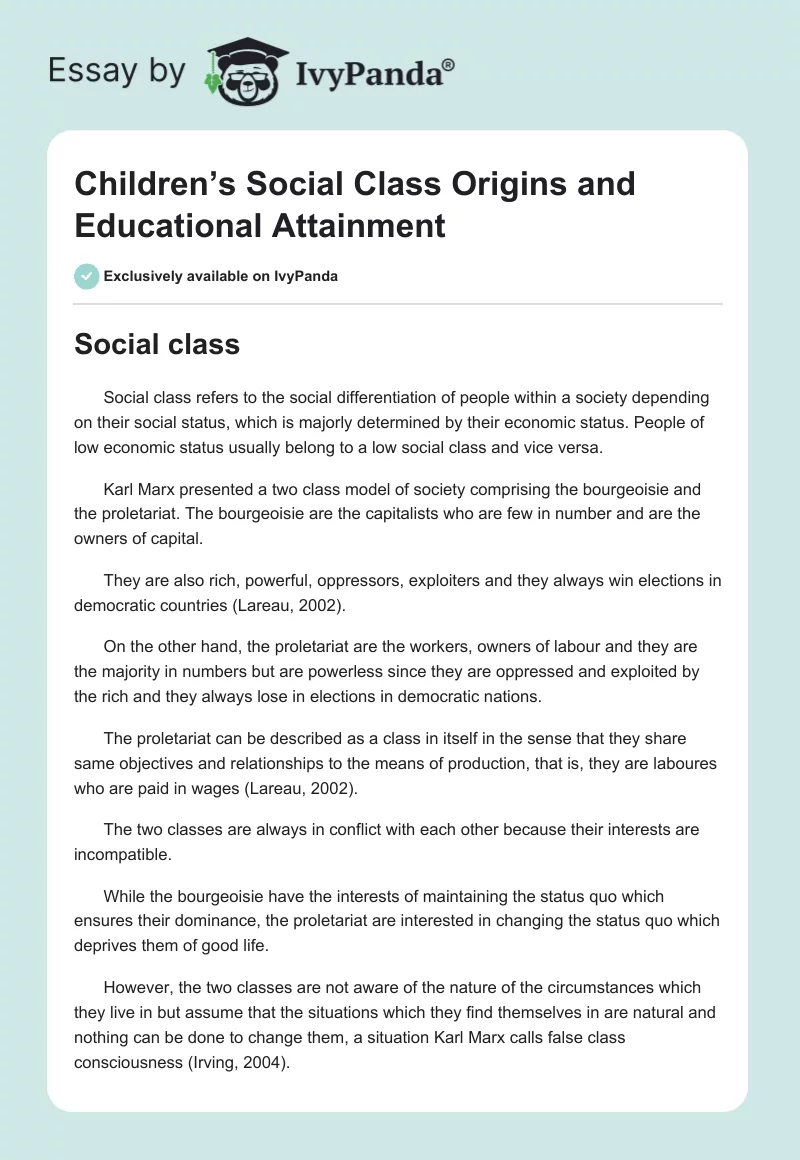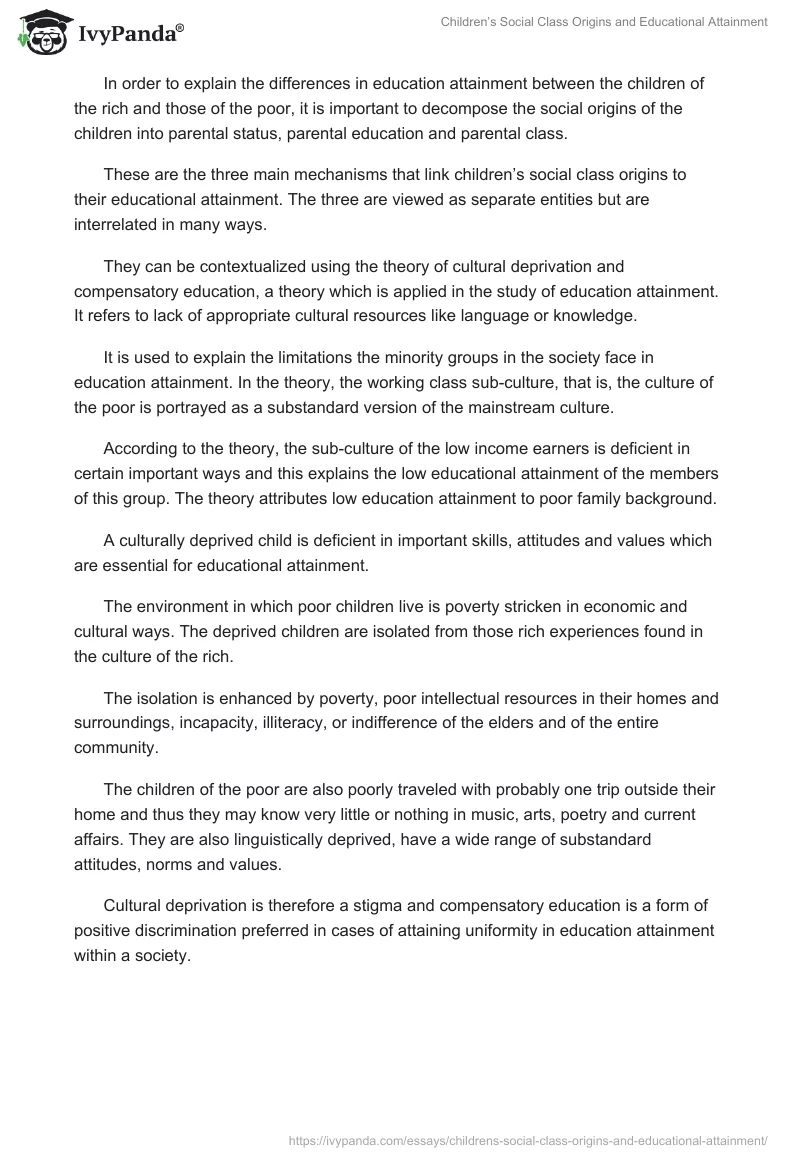Social class
Social class refers to the social differentiation of people within a society depending on their social status, which is majorly determined by their economic status. People of low economic status usually belong to a low social class and vice versa.
Karl Marx presented a two class model of society comprising the bourgeoisie and the proletariat. The bourgeoisie are the capitalists who are few in number and are the owners of capital.
They are also rich, powerful, oppressors, exploiters and they always win elections in democratic countries (Lareau, 2002).
On the other hand, the proletariat are the workers, owners of labour and they are the majority in numbers but are powerless since they are oppressed and exploited by the rich and they always lose in elections in democratic nations.
The proletariat can be described as a class in itself in the sense that they share same objectives and relationships to the means of production, that is, they are laboures who are paid in wages (Lareau, 2002).
The two classes are always in conflict with each other because their interests are incompatible.
While the bourgeoisie have the interests of maintaining the status quo which ensures their dominance, the proletariat are interested in changing the status quo which deprives them of good life.
However, the two classes are not aware of the nature of the circumstances which they live in but assume that the situations which they find themselves in are natural and nothing can be done to change them, a situation Karl Marx calls false class consciousness (Irving, 2004).
In order to explain the differences in education attainment between the children of the rich and those of the poor, it is important to decompose the social origins of the children into parental status, parental education and parental class.
These are the three main mechanisms that link children’s social class origins to their educational attainment. The three are viewed as separate entities but are interrelated in many ways.
They can be contextualized using the theory of cultural deprivation and compensatory education, a theory which is applied in the study of education attainment. It refers to lack of appropriate cultural resources like language or knowledge.
It is used to explain the limitations the minority groups in the society face in education attainment. In the theory, the working class sub-culture, that is, the culture of the poor is portrayed as a substandard version of the mainstream culture.
According to the theory, the sub-culture of the low income earners is deficient in certain important ways and this explains the low educational attainment of the members of this group. The theory attributes low education attainment to poor family background.
A culturally deprived child is deficient in important skills, attitudes and values which are essential for educational attainment.
The environment in which poor children live is poverty stricken in economic and cultural ways. The deprived children are isolated from those rich experiences found in the culture of the rich.
The isolation is enhanced by poverty, poor intellectual resources in their homes and surroundings, incapacity, illiteracy, or indifference of the elders and of the entire community.
The children of the poor are also poorly traveled with probably one trip outside their home and thus they may know very little or nothing in music, arts, poetry and current affairs. They are also linguistically deprived, have a wide range of substandard attitudes, norms and values.
Cultural deprivation is therefore a stigma and compensatory education is a form of positive discrimination preferred in cases of attaining uniformity in education attainment within a society.
Parental status
The status of parents refers to the way parents are perceived within a society. They can either be of high or low social status, depending on their levels of income. Parents who have high income enjoy a higher status than those who earn little or no income.
Parents who are of high status are able to take their children to good schools which are fully equipped with excellent learning infrastructure. Due to this, their children are able to do well in education.
On the other hand, parents of low social status are not able to take their children to school or in other words, they take their children to schools which are poorly equipped with learning infrastructure.
As a result, the children have minimal chances of doing well as compared to those of parents of high status (Saltiel, 2013).
Parental class
It refers to the social class of parents. As explained above, there are two social classes in the society namely the proletariat and the bourgeoisie. Parent’s social class is closely related to parent’s social status. Parents of low social class enjoy a low social status.
They are literally the poor or low income earners in the society. Due to their poverty, the proletariat are not able to take their children to good schools. Some are not even able to take their children to school at all.
Those children of the poor who are lucky enough to do well even under the poor learning conditions are given some affirmative action by their governments. An example of affirmative action is the sponsorship of children to pursue higher education (Lareau, 2002).
On the other hand, parents of high social class are able to take their children to the best schools. The reason is that they are able to afford the high fees charged in those schools.
The schools themselves also enjoy high social status within the community, with majority being owned by individuals and others belonging to governments.
The learning environment is therefore very conducive and this makes the children do very well in exams as compared to their counterparts in the poor schools.
Parental education
This refers to the amount of education attained by parents. It is closely related both to parental class and status. Parents of high social status are more likely to have attained a higher education than those of low social status.
Similarly, parents who belong to the bourgeoisie class are more likely to be more educated than their proletariat counterparts.
However, there are some parents who may belong to a high social status and social class but not necessarily have attained higher education.
Similarly, there can be some parents who are relatively educated but may not enjoy high social class or social status due to various reasons such as lack of employment or simply by choice.
The amount of education attained by the parents has a direct relationship with that of their children. Children of parents with low levels of education are more likely to be poorly educated than those of parents with higher education.
One of the reasons is that poorly educated parents may not know the importance of educating their children because to them education does not matter a lot in life.
Poorly educated parents are also likely to be poor and of the low social status. They are therefore not able to afford to pay for the education of their children due to low incomes (Kohn, 1977).
On the other hand, parents who have higher education are likely to have their children attain higher education. The reason is that the parents know the importance of education, having tasted the fruits of good education.
They are in a position to understand that educating their children has a direct relationship with their bright future. Well educated parents are also likely to have the resources to educate their children because they are likely to be employed and enjoying high social and economic status.
Well educated parents are also socialized through the education system and therefore are more likely to socialize their children through the education system than their uneducated or poorly educated counterparts (Beller, 2009).
The three components of social origin of the children, namely the parents’ class, education and status therefore influence the attainment of education for the children.
Children of the poor parents should not be blamed for not attaining education but rather, they should be viewed as being marginalized.
Children of the rich on the other hand should not be viewed as brighter than those of poor parents but rather, they should be viewed just as being privileged to belong to well to do families. In other words, any child can do well in education if all factors are held constant.
That is, if all children were to be exposed to similar social, cultural and economic backgrounds, then the variations in education attainment would be very minimal (Edin and Lein, 1997).
References
Beller, E. (2009). “Bringing Intergenerational Social Mobility Research into the Twenty‐first Century: Why Mothers Matter”, American Sociological Review, 74(4), 507-528.
Edin, K., and Lein, L. (1997). Making Ends Meet: How Single Mothers Survive Welfare and Low‐Wage Work, Chapter 3 portion of Chapter 8, 103(3), 224‐227.
Irving, D. (2004). Model of Psychological Functioning. Web.
Kohn, L. M. (1977). Class and Conformity: A Study in Values, With a Reassessment. Chicago: University of Chicago Press.
Lareau, A. (2002). “Invisible Inequality: Social Class and Childrearing in Black Families and White Families”, American Sociological Review, 67(5), 747-776.
Saltiel, J. (2013). The Wisconsin Model of Status Attainment and the Occupational Choice Process Applying a Continuous-Choice Model to a Discrete-Choice Situation. Web.


